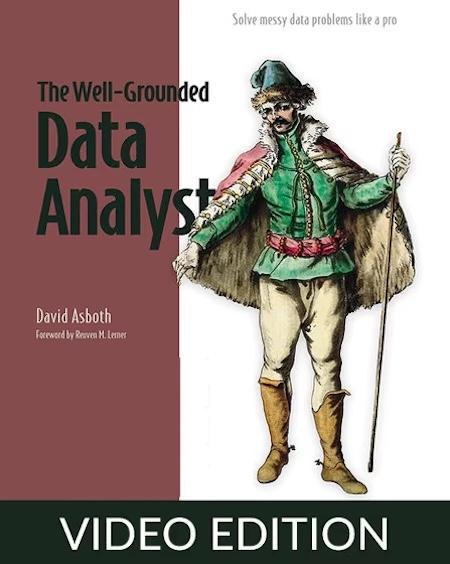English | MP4 | AVC 1280×720 | AAC 44KHz 2ch | 10h 6m | 1.43 GB
Complete eight data science projects that lock in important real-world skills—along with a practical process you can use to learn any new technique quickly and efficiently.
Data analysts need to be problem solvers—and The Well-Grounded Data Analyst will teach you how to solve the most common problems you’ll face in industry. You’ll explore eight scenarios that your class or bootcamp won’t have covered, so you can accomplish what your boss is asking for.
In The Well-Grounded Data Analyst you’ll learn:
- High-value skills to tackle specific analytical problems
- Deconstructing problems for faster, practical solutions
- Data modeling, PDF data extraction, and categorical data manipulation
- Handling vague metrics, deciphering inherited projects, and defining customer records
The Well-Grounded Data Analyst is for junior and early-career data analysts looking to supplement their foundational data skills with real-world problem solving. As you explore each project, you’ll also master a proven process for quickly learning new skills developed by author and Half Stack Data Science podcast host David Asboth. You’ll learn how to determine a minimum viable answer for your stakeholders, identify and obtain the data you need to deliver, and reliably present and iterate on your findings. The book can be read cover-to-cover or opened to the chapter most relevant to your current challenges.
Real world data analysis is messy. Success requires tackling challenges like unreliable data sources, ambiguous requests, and incompatible formats—often with limited guidance. This book goes beyond the clean, structured examples you see in classrooms and bootcamps, offering a step-by-step framework you can use to confidently solve any data analysis problem like a pro.
The Well-Grounded Data Analyst introduces you to eight scenarios that every data analyst is bound to face. You’ll practice author David Asboth’s results-oriented approach as you model data by identifying customer records, navigate poorly-defined metrics, extract data from PDFs, and much more! It also teaches you how to take over incomplete projects and create rapid prototypes with real data. Along the way, you’ll build an impressive portfolio of projects you can showcase at your next interview.
What’s Inside
- Deconstructing problems
- Handling vague metrics
- Data modeling
- Categorical data manipulation
Table of Contents
1 Chapter_1._A_results-driven_approach
2 Chapter_1._Bridging_the_gap_between_data_science_training_and_the_real_world
3 Chapter_1._Project_structure
4 Chapter_1._Summary
5 Chapter_2._An_example_solution_Finding_London
6 Chapter_2._Encoding_geographiesEncoding_geographies
7 Chapter_2._How_to_use_the_rest_of_the_book
8 Chapter_2._Summary
9 Chapter_3._An_example_solution_Identifying_customers_from_transactional_data
10 Chapter_3._Closing_thoughts_on_data_modeling
11 Chapter_3._Data_modeling
12 Chapter_3._Planning_our_approach_to_customer_data_modeling
13 Chapter_3._Project_2_Who_are_your_customers
14 Chapter_3._Summary
15 Chapter_4._An_example_solution_Finding_the_best_performing_products
16 Chapter_4._Applying_the_results-driven_method_to_different_metric_definitions
17 Chapter_4._Closing_thoughts_on_metrics
18 Chapter_4._Metrics
19 Chapter_4._Project_3_Defining_precise_metrics_for_better_decision_making
20 Chapter_4._Summary
21 Chapter_5._An_example_solution_Effects_of_the_COVID-19_lockdown_periods_on_the_film_industry
22 Chapter_5._Applying_the_results-driven_method_to_extracting_data_from_PDFs
23 Chapter_5._Closing_thoughts_on_exploring_novel_data_sources
24 Chapter_5._Project_4_Analyzing_film_industry_trends_using_PDF_data
25 Chapter_5._Summary
26 Chapter_5._Unusual_data_sources
27 Chapter_6._An_example_solution_How_do_developers_use_AI
28 Chapter_6._Applying_the_results-driven_method_to_analyzing_the_developer_survey
29 Chapter_6._Categorical_data
30 Chapter_6._Project_5_Analyzing_a_survey_to_understand_developer_attitudes_toward_AI_tools
31 Chapter_6._Summary
32 Chapter_7._Categorical_data_Advanced_methods
33 Chapter_7._Closing_thoughts_on_categorical_data
34 Chapter_7._Summary
35 Chapter_7._Using_advanced_methods_to_answer_further_questions_about_categorical_data
36 Chapter_8._An_example_solution_Where_should_cycling_infrastructure_improvements_be_focused
37 Chapter_8._Applying_the_results-driven_method_to_analyzing_road_traffic_data
38 Chapter_8._Project_6_Analyzing_time_series_to_improve_cycling_infrastructure
39 Chapter_8._Summary
40 Chapter_8._Time_series_data_Data_preparation
41 Chapter_9._Closing_thoughts_Time_series
42 Chapter_9._Summary
43 Chapter_9._Time_series_data_Analysis
44 Chapter_9._Where_should_cycling_infrastructure_improvements_be_focused
45 Chapter_10._An_example_solution_Building_a_prototype_to_explore_using_house_price_data
46 Chapter_10._Applying_the_results-driven_method_to_investigating_Welsh_property_data
47 Chapter_10._Project_7_Build_a_proof_of_concept_to_investigate_Welsh_property_prices
48 Chapter_10._Rapid_prototyping_Data_analysis
49 Chapter_10._Summary
50 Chapter_11._Building_a_proof_of_concept
51 Chapter_11._Closing_thoughts_on_the_rapid_prototyping_of_ideas
52 Chapter_11._Rapid_prototyping_Creating_the_proof_of_concept
53 Chapter_11._Summary
54 Chapter_12._An_example_solution_Creating_customer_segments
55 Chapter_12._Applying_the_results-driven_method_to_creating_the_second_iteration_of_a_customer_segmentation
56 Chapter_12._Continuing_someone_else_s_work
57 Chapter_12._Iterating_on_someone_else_s_work_Data_preparation
58 Chapter_12._Project_8_Finding_customer_segments_from_mobile_activity
59 Chapter_12._Summary
60 Chapter_13._Closing_thoughts_Segmentation_and_clustering
61 Chapter_13._Iterating_on_someone_else_s_work_Customer_segmentation
62 Chapter_13._Summary
Resolve the captcha to access the links!
